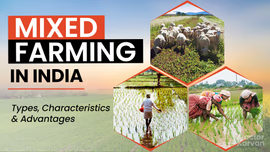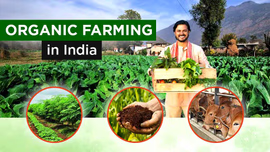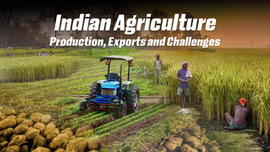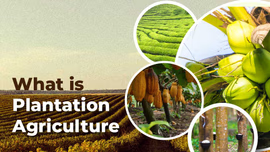Understanding Types of Agriculture in India

Table of Contents
Types of Agriculture in India
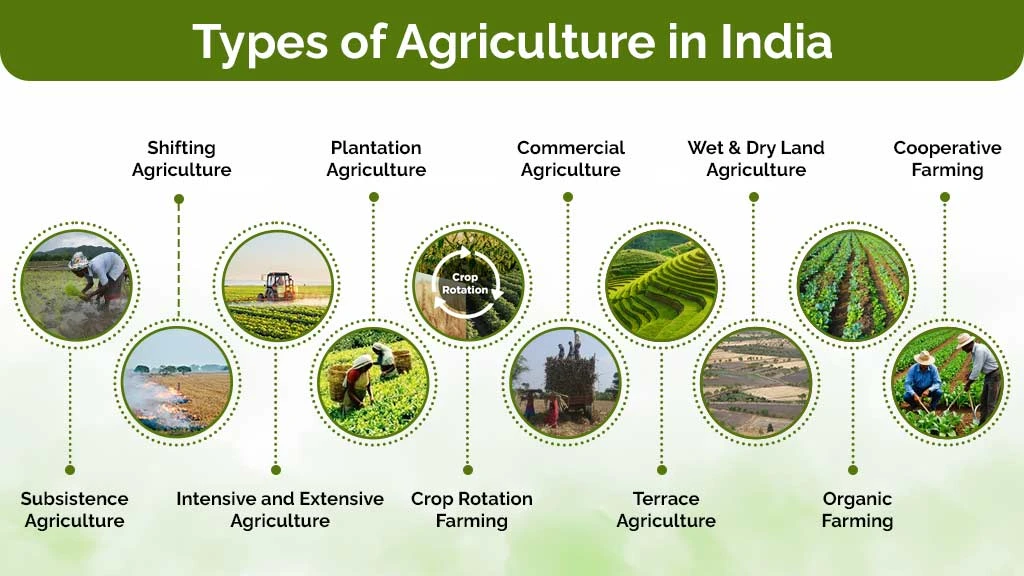
Agriculture is one of the most comprehensive words which denotes the union of crop plants and domestic animals. This union provides food and other products to global human population for survival. The agriculture has evolved over years according to the human and environment requirements. Let’s dive into some of the different types of agriculture that India has experienced over the years.
Subsistence Agriculture
Subsistence agriculture is a primitive agricultural practice which is also known as family farming. It is a form of farming in which mainly all the crops are produced to serve the needs of the farmer and his family. Majority of the farmers in our country practice subsistence agriculture. The landholdings are small and fragmented in this type of farming due to which they have low yields and don’t have any surplus to sell in the market. Subsistence agriculture does not allow capital accumulation which limits the farmers from getting financial resources to buy farming inputs to increase their productivity and hire labor. The techniques and tools used for cultivation are quite simple and primitive. There is absence of tractors, modern farming tools, and fertilizers, pesticides, or insecticides. Farmers mainly cultivate wheat, rice, millets, pulses, etc. in subsistence agriculture.
Shifting Agriculture
The origin of shifting cultivation on the basis of archaeological evidence and radio-carbon dating is traced back to 8000 BC in the neolithic period. This slash and burn agricultural type are known as Jhum in India mainly in the Northeast. It basically involves the rotation of fields rather than rotation of crops. This traditional farming technique characterized the use of human labor only because of the absence of draught animals. The cultivation was practiced with primitive tools like dibble sticks or hoe.
In this type of agriculture, firstly the vegetation on the chosen land is cut and burnt for releasing the soil nutrients in order to prepare a fertile planting bed. After this the fresh crops are planted, nurtured, and harvested on maturing. Once the soil fertility decreases after two or three years, the fields are abandoned for 15 to 20 years so that the soil rejuvenates. The cultivators then shift to another piece of land and apply the same method. This tribal practice involves selecting the land based on the soil texture in the month of December or January, worshipping evil spirits, sacrifices before sowing. However, shifting agriculture leads to many soil and climate related challenges like soil erosion, loss of soil fertility, nutrient imbalances, and extreme weather events.
Intensive Farming and Extensive Farming
Intensive farming is one of the methods of agriculture in India which is labor intensive and is practiced mainly in densely populated regions. It is a type of agriculture in which many crops are grown together on very small lands. It is mainly practiced in developing countries of south-east Asia like India, Japan, China, etc. where majorly agriculture is the main source of livelihood. It involves the maximum use of labor, fertilizers, and high-yielding seeds for getting the highest yield per hectare. Due to heavy pressure of population on the land the maximum crop production of rice, wheat, etc. is done for providing food security. However, this intensification of crop production leads to land degradation and overall food chain pollution.
On the other hand, extensive farming is completely opposite to intensive farming. In this type of agriculture, the large area of land is used to relatively produce low yields with less intensive labor and a very minimal use of farm inputs like fertilizers or pesticides. It relies on natural rainfall for irrigation rather than artificial irrigation systems. Usually, one crop a year is raised on the farm to avoid the overuse of soil. It however involves extensive use of machines and is mainly practiced in developed countries.
Plantation Agriculture
Plantation agriculture is an extensive type of commercial farming where a large area of land is used for the plantation of high-value crops. Thus, it mainly involves cultivating cash crops on a large scale to earn profit. Also, farmers need to invest a significant amount of capital and labor to grow plantation crops. Plantation farming is practiced worldwide but it is most common in tropical and subtropical regions. It involves bush or tree farming mainly of a single crop like rubber, coconut, cocoa, spices, etc. on huge areas. Most of the crops in this type of agriculture have a life span beyond two years.
Crop Rotation Farming
The crop rotation is a type of farming technique which involves planting a set of different crops on a piece of land sequentially according to seasons. However, it requires proper planning like a legume crop is followed by high-nitrogen demanding crop. This helps in improving the soil health, optimizing the soil nutrients. It also prevents soil diseases, pests and weed problems.
Commercial Agriculture
Commercial agriculture as the name suggests is particularly practiced for financial profit unlike the subsistence agriculture which was performed to meet only the personal needs. This type of agriculture focuses on producing the agricultural products for sale and not completely for subsistence purposes. The main purpose is to generate high profits by maximum yields on a large scale with a view of exporting them internationally. This plays a vital role in meeting the needs of the global population.
Terrace Agriculture
Terrace agriculture is a method of growing crops on the hillsides by planting them on terraces created by cutting of the slopes. Due to scarcity of the availability of flat land, terraces are made to provide a small patch of level land. These terraces resemble a series of steps, so it is also known as step farming. Terrace cultivation is one of India's most practiced types of agriculture in hilly regions. The main areas where it is practiced in India are Kashmir Valley and Northeast, the Himalayan regions, and certain areas of the Western Ghats. Tea, coffee, maize, vegetables, rice, etc. are some of the crops cultivated in terrace agriculture.
Wet Land Farming and Dry Land Farming
Wet land farming depends mainly upon rains, so it is practiced in high rainfall or well irrigated areas, particularly near a water body. Rice, jute, and sugarcane are grown in this type of agriculture because of their water requirements. It is prevalent in the north, north-eastern India and on the slopes of the Western Ghats.
Dry land farming on the other hand can be defined as a practice of growing crops without irrigation in areas which mainly receive an annual rainfall of 750 mm – 500 mm or even less. In this type of agriculture crops like gram, jowar, bajra and peas are grown because they require less water. It is practiced in low rainfall areas or where there is inappropriate irrigation facility, majorly in the western, north-western India and central India.
Organic Farming
Organic farming, as the name suggests, is an ecological production system which promotes the enhancement of biodiversity, biological cycles and soil activity. It is based on using minimal inputs and management practices which maintain ecological harmony. It achieves its motive by eliminating the use of synthetic inputs like pesticides, fertilizers, veterinary, drugs, genetically modified seeds and breeds, preservatives and additivities. These are replaced with site specific management practices like crop rotations, crop residues, animal manures, organic waste, mineral grade rock additives, etc. They help in maintaining soil productivity, supply plant nutrients, control insect, weeds and other pests. Organic methods can not only repair decades of environmental damage but can also knit small farm families into more sustainable distribution networks leading if they organize themselves in production, certification, and marketing which will ultimately provide more health and food security to the consumers.
Cooperative Farming
Cooperative farming, as the name implies, is a type of agriculture in which farming operations are conducted voluntarily by the farmers on their lands and resources with agencies and other farmers. This cooperation does not affect the right to land of farmers. All of the farms are managed as a single unit by the management which is elected by all the members. The agencies on behalf of the farmers collect farming inputs like fertilizers, seeds, farming equipment, etc. They also assist the farmers in selling their agricultural products. This incorporation allows small farmers to practice like big farmers. They get to buy inputs and equipment at low or bulk rates and they also get access to new markets. This helps these farmers to generate more income which ultimately improves their financial condition.
Conclusively, all of these types of agriculture are practiced on the basis of soil, climate, and socioeconomic requirements. Farmers along with the help of government and corporates should attempt in blending traditional expertise with advanced technologies. However, the approach should be inclined towards sustainability.
Frequently Asked Questions On Understanding Types of Agriculture in India
1. What are the types of agriculture in India?
There are various types of agriculture in India like subsistence agriculture, shifting agriculture, plantation agriculture, commercial agriculture, intensive farming, organic farming, cooperative farming, etc.
2. What are the types of commercial agriculture?
The types of commercial agriculture are extensive farming and plantation agriculture.
3. Which type of agriculture is Jhumming?
Shifting agriculture is known as Jhumming mainly in the Northeast of India.
4. What are the types of modern agriculture?
Intensive farming, organic farming, sustainable agriculture, etc. are the types of modern agriculture.
5. what is the best type of soil for agriculture?
Loamy soil is considered as the best type of soil for agriculture because of higher productivity.


Related Blogs
